
- Usage in publication:
-
- Curlew limestone member
- Modifications:
-
- Original reference
- Dominant lithology:
-
- Limestone
- Chert
- AAPG geologic province:
-
- Illinois basin
Summary:
Pl. showing section of Lower Coal Measures; 1857, Kentucky Geol. Survey, v. 3, p. 13, 23. Curlew limestone in Lower Coal Measures. Limestone, 4 feet thick; separated from overlying Curlew sandstone by 34 feet of shale, including Curlew coal and with sandstone or limestone at top.
Apparently named from Curlew, Union Co., KY.
[Adopted by the USGS (ca. 1936) as Curlew limestone member of Tradewater formation. Age is Pennsylvanian. Present in western Kentucky and southeastern Illinois(?).]
Source: US geologic names lexicon (USGS Bull. 896, p. 556).
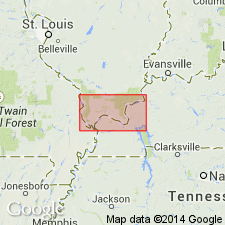
- Usage in publication:
-
- Curlew limestone
- Modifications:
-
- Revised
- AAPG geologic province:
-
- Illinois basin
Summary:
Pg. 40. Curlew limestone in Macedonia formation. Occurs in Macedonia formation about 20 or 30 feet above a more or less local sandstone that lies above the Murray Bluff sandstone. Light gray, compact, and generally 3 to 4 feet thick; contains chert; and locally weathers to a porous cherty residium. Age is Middle Pennsylvanian.
Source: US geologic names lexicon (USGS Bull. 1200, p. 1009-1010).
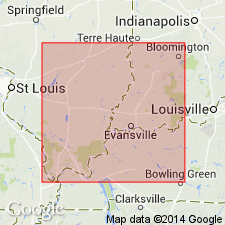
- Usage in publication:
-
- Curlew limestone
- Modifications:
-
- Revised
- Areal extent
- AAPG geologic province:
-
- Illinois basin
Summary:
Pg. 15 (fig. 2), 18, 20-21 [1943]. Curlew limestone of Tradewater group. Included in Tradewater group. Occurs in Macedonia cyclothem above Murray Bluff sandstone and below Curlew coal and Curlew sandstone in Stonefort cyclothem. Light-colored limestone, very siliceous and cherty, and locally grades into a bed of solid chert. Thickness variable, maximum 5 to 6 feet. Known from Williamson County, Illinois, to Butler County, Kentucky.
[GNC remark (ca. 1966, US geologic names lexicon, USGS Bull. 1200, p. 1010): USGS has discontinued the use of the name Tradewater in Illinois.]
Source: US geologic names lexicon (USGS Bull. 1200, p. 1009-1010).
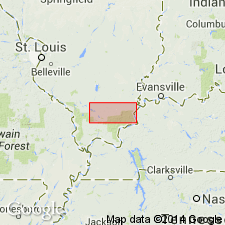
- Usage in publication:
-
- Curlew limestone
- Modifications:
-
- Revised
- AAPG geologic province:
-
- Illinois basin
Summary:
Pg. 8 (fig. 2), 9. Curlew limestone of Tradewater group. Overlies Creal Springs sandstone (new) in vicinity of Creal Springs.
[GNC remark (ca. 1966, US geologic names lexicon, USGS Bull. 1200, p. 1010): USGS has discontinued the use of the name Tradewater in Illinois.]
Source: US geologic names lexicon (USGS Bull. 1200, p. 1009-1010).
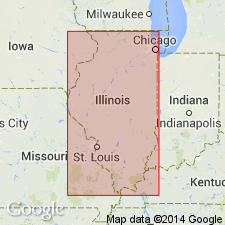
- Usage in publication:
-
- Curlew limestone member
- Modifications:
-
- Revised
- AAPG geologic province:
-
- Illinois basin
Summary:
Pg. 32, 45. Curlew limestone member of Spoon formation (new) of Kewanee group (new). Reallocated to member status in Spoon formation [in Illinois]. Overlies New Burnside coal member; underlies O'Nan coal member. Age is Pennsylvanian. Presentation of new rock-stratigraphic classification of Pennsylvanian of Illinois.
Type locality (Owen, 1856, vertical diagram 1): south side of Indian Hill, near Curlew, Shawneetown quadrangle, Union Co., western KY.
Source: Publication; US geologic names lexicon (USGS Bull. 1200, p. 1009-1010).
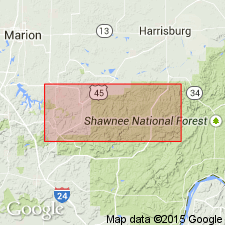
- Usage in publication:
-
- Curlew Limestone Member
- Modifications:
-
- Areal extent
- AAPG geologic province:
-
- Illinois basin
Summary:
Strata in southern IL referred to Curlew by Butts (1925) and Weller (1940) here named Mitchellsville Limestone Bed of Spoon Formation. Palynological studies confirm that this limestone is much younger than the type Curlew at Indian Hill, Union Co., KY.
Source: GNU records (USGS DDS-6; Reston GNULEX).
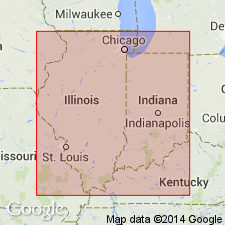
- Usage in publication:
-
- Curlew Member
- Modifications:
-
- Overview
- AAPG geologic province:
-
- Illinois basin
Summary:
Physical correlation indicates that the type Perth Limestone of northern Clay Co., IN, is equivalent to the Lewisport Limestone in KY. The Lewisport, in turn, is equivalent to the Curlew Limestone Member. Correlations have been confirmed by faunal evidence. The Perth/Curlew is composed of one or more limestone beds that intergrade laterally with shale and siltstone containing marine fossils.
Source: GNU records (USGS DDS-6; Reston GNULEX).
For more information, please contact Nancy Stamm, Geologic Names Committee Secretary.
Asterisk (*) indicates published by U.S. Geological Survey authors.
"No current usage" (†) implies that a name has been abandoned or has fallen into disuse. Former usage and, if known, replacement name given in parentheses ( ).
Slash (/) indicates name conflicts with nomenclatural guidelines (CSN, 1933; ACSN, 1961, 1970; NACSN, 1983, 2005, 2021). May be explained within brackets ([ ]).

